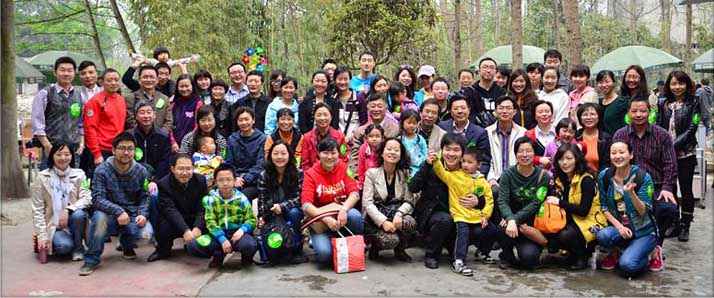Introduction to SFL

From the founding of the Imperial Chinese Railway College (the origin of SWJTU) in 1896, the first students had courses taught in foreign languages according to their curriculum. It has been about 120 years during which both the teaching of foreign languages and teaching in a foreign language have been developed and adjusted to meet China’s social needs.
Without there being a proper system for higher education in China in 1896, the Imperial Chinese Railway College in Shanhaiguan (located in North China’s Hebei province) had to design and base its curriculum on a western one. All the courses, except Advanced Chinese, were taught in English by foreign teachers (then known as tutors) with the original textbooks all being in English. Professor Challe from Germany, Professor Sprague from America and Professor Griffith from Britain served successively as Chief Tutor from 1896 to 1908. The school’s history shows that English, Mathematics and Physics were compulsory courses, and the English course including grammar, composition and conversation. In a student’s graduation certificate, the names of the main courses as well as the grades that he earned would be specified.
When the Imperial Chinese Railway College changed its name to Tangshan Mine Road School at the beginning of the 20th century, it kept on following the European and American education system and its main courses were taught in English by foreign teachers. According to the curriculum, the students would learn most of their required courses in English throughout their four college years. At the same time, the school also offered courses in either German or French. During this period, English and German became the two main teaching languages. After the National Jiao Tong University was set up, it was based on the Tangshan Mine Road School in 1921, and its curriculum required that English, French and German be offered for the Preps Grade 1 and Preps Grade 2, whilst only English was offered to freshmen. Tangshan Engineering College was the temporarily new name for the National Jiao Tong University during the period from 1946 to 1949, during which period the freshmen from all departments were required to learn English according to a revised curriculum.
From September 15th 1949, more Chinese teachers were recruited and more textbooks were written in Chinese. In December of that same year, Chinese, English, Russian and Japanese were also listed among the selective courses. Original Russian textbooks were introduced in October of 1952, and some Soviet experts such as Novikov and Cvetov taught at the university as faculty members. In the 1970s, the National Jiao Tong University moved to Emei in Sichuan province. To sum up, after the founding of the People’s Republic of China in 1949, foreign language teaching and learning has always officially been included in the curriculum of all departments.
The Department of Foreign Languages was set up in 1985, and had its first enrollment in 1987, and consequently developed into the School of Foreign Languages in 2001. During its 30-year history, the SFL set up and run six key undergraduate majors including English, French, German, Japanese, Chinese as a Second Language, Translation; one primary discipline master program in Foreign Language and Literature with five secondary discipline programs including English Language and Literature, French Language and Literature, German Language and Literature, Japanese Language and Literature, Foreign Linguistics and Applied Linguistics, and one master program for Translation and Interpretation (MTI). In addition, the SFL, in collaboration with School of Arts and Communication, offers a primary discipline doctoral program in Chinese Language and Literature which enrolls students in Medio-translatology and Translation Study. In 2013, there were 1206 undergraduates, master students and doctoral students studying at SFL, among whom there were 132 foreign students from 65 countries and regions. The SFL also undertakes the teaching of foreign languages (English, Japanese, German, French and Russian) to the non-English majors of SWJTU.
The SFL is organized into 8 departments: English Language and Literature, English for Engineering, Japanese, German, French, International Chinese, Translation and Interpreting, and Russian. It also runs 6 institutes which respectively focus on theoretical linguistics, translation and cross-culture research, applied linguistics, the international promotion of Chinese, technology for modern foreign language education, and foreign languages for engineering purposes. Additionally, the SFL has established 3 centers for foreign language training, international education, and network management and development.
The SFL has 187 staff members, 176 are teachers which includes 17 professors, 36 associate professors, 118 lecturers and 5 assistant lecturers. There are also 28 master and doctoral advisors. The SFL is proud of its faculty members who hold impressive academic positions in various committees and societies: 1 committee member of the International Federation of Translators, 1 vice president of the education administrative committee of the Chinese society of Education, 1 deputy director and 2 committee members of the National Foreign language Teaching Advisory Board in the Ministry of Education, 1 president of the Society of Translation Literature of Sichuan province, 2 vice presidents of the College English Teaching and Research Association of Sichuan Province, 1 vice president of the Society of Comparative Literature of Sichuan Province.
Collaboration between different languages and subjects is an important characteristic of the teaching and research being done at the SFL. The SFL has successfully built 2 national quality courses, 1 national pilot demonstration center for teaching reform, 2 provincial quality courses, 3 college-level quality courses. With 1 provincial excellence teaching team and 1 college-level excellence graduate adviser team, the faculty has been received high recognition for its teaching and research including 7 second national prize winners for Teaching Achievements, 7 first prize winners for achievements in philosophy and social science awarded by the Sichuan provincial government, and 15 first provincial prize winners for teaching Achievements. Presently, the faculties are undertaking 3 national projects with social science funds, 5 research projects on humanities and social sciences sponsored by the Ministry of Education, 17 provincial research projects and 34 cross-sectional research projects.